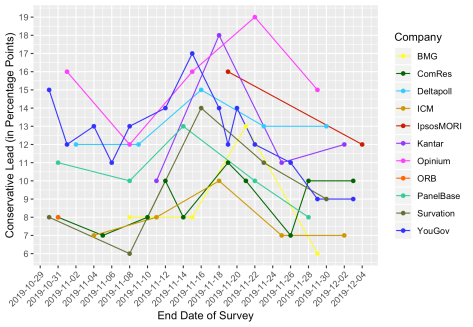By Stephen Fisher, John Kenny and Rosalind Shorrocks
Since our first combined forecast at the start of the campaign, the number of forecasts for this general election has grown substantially. All of the combined forecasts – seats, vote shares, and probabilities – are pointing to a Conservative majority. However, some individual forecasts do predict a hung parliament, and there is variation within each forecast type over how certain this majority is, and how large it is predicted to be.
SEATS
Seat projections from the betting markets, complex models, and simple models are all very similar, forecasting a Conservative majority of between 343 and 351 seats. The average number of seats across all forecasts that the Conservatives are expected to win – 341 – is slightly lower but ultimately very similar to the forecast last week.
Since last week the Political Studies Association have published their Expert Survey, in which the average expected number of Conservative seats suggests a hung parliament with the Conservatives just shy of a majority. It is interesting that the experts surveyed by the PSA predict the Conservatives will win fewer seats than is currently suggested by the polls. Perhaps they are factoring in the same kind of late-campaign changes as observed in 2017 – although it should be noted that when a similar kind of survey was run for the EU referendum in 2016, the average predicted vote share for Remain and Leave amongst experts was the furthest away from the actual result than any of the other types of forecast. They also predicted a Conservative majority in 2017, although that prediction was made much more earlier in the campaign when the Conservatives had considerable leads over Labour in the polls.
| Seats | Betting Markets | Complex models | Simple models | Experts | Average |
| Con | 346 | 343 | 350 | 324 | 341 |
| Lab | 221 | 225 | 219 | 233 | 224 |
| LD | 18 | 17 | 18 | 25 | 19 |
| Brexit | 0 | 0 | 0 | 2 | 1 |
| Green | 1 | 1 | 1 | 2 | 1 |
| SNP | 43 | 44 | 41 | 42 | 43 |
| PC | 4 | 3 | 3 | 4 | 4 |
| Con majority | 42 | 37 | 49 | -2 | 31 |

The similarity between the seat projections from most sources hides considerable variation within one particular forecast type – complex models. These models range from predicting 311 Conservative seats to 366 – the difference between a hung parliament and a healthy Conservative majority. They also range between 190 and 268 for Labour. It is particularly noteworthy that the voter expectation model, from Murr, Stegmaier, and Lewis-Beck, which uses citizen forecasts to predict the number of seats, forecasts one of the highest number of Conservative seats (360) and the lowest number of Labour seats (190). This is in contrast to our implied probability calculated from the citizen forecasts, which suggest that citizens are in general the least convinced about the likelihood of a Conservative majority compared to other forecasting methods. This suggests these surveys also suffer from being open to multiple interpretations and methods of analysis, as well as the question wording effects we discussed last week.
Continue reading Final combined forecast for the 2019 general election


